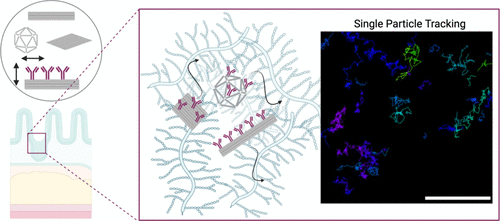拓扑结构决定肠黏液中DNA折纸扩散
IF 9.1
1区 材料科学
Q1 CHEMISTRY, MULTIDISCIPLINARY
引用次数: 0
摘要
由于纳米颗粒设计和粘液运输之间的关系复杂且知之甚少,因此有效地跨越粘膜屏障的纳米药物递送仍然是一个挑战。在这里,我们提出DNA折纸作为研究纳米颗粒形状和配体图案如何影响粘液扩散的平台。通过将这些参数解耦,同时保持相同的材料成分,我们通过高分辨率单粒子跟踪系统地评估了棒状、二十面体和矩形纳米结构的扩散。我们的研究结果表明,黏液中的扩散性不仅取决于形状或功能化,还取决于它们的相互作用:虽然未修饰的杆状体扩散较差,但它们的流动性在抗体功能化后显着增加,在中等配体密度时达到最大值。相比之下,棒体和二十面体对表面修饰的反应不那么明显和非最佳。这些发现强调了拓扑特异性优化在纳米颗粒设计中的重要性,并证明了DNA纳米技术在揭示下一代穿透黏液给药系统设计规则方面的实用性。本文章由计算机程序翻译,如有差异,请以英文原文为准。

Topology Determines DNA Origami Diffusion in Intestinal Mucus
Efficient nanomedicine delivery across mucosal barriers remains a challenge due to the complex and poorly understood relationship between nanoparticle design and mucus transport. Here, we present DNA origami as a platform to investigate how the nanoparticle shape and ligand patterning influence diffusivity in mucus. By decoupling these parameters while maintaining identical material composition, we systematically evaluated the diffusion of rod, icosahedral, and rectangular nanostructures by using high-resolution single-particle tracking. Our results reveal that diffusivity in mucus is not solely determined by shape or functionalization alone but by their interplay: while unmodified rods diffused poorly, their mobility increased significantly upon antibody functionalization, reaching a maximum at an intermediate ligand density. In contrast, rods and icosahedra exhibited less pronounced and nonoptimal responses to surface modification. These findings highlight the importance of topology-specific optimization in nanoparticle design and demonstrate the utility of DNA nanotechnology to uncover design rules for next-generation mucus-penetrating drug delivery systems.
求助全文
通过发布文献求助,成功后即可免费获取论文全文。
去求助
来源期刊

Nano Letters
工程技术-材料科学:综合
CiteScore
16.80
自引率
2.80%
发文量
1182
审稿时长
1.4 months
期刊介绍:
Nano Letters serves as a dynamic platform for promptly disseminating original results in fundamental, applied, and emerging research across all facets of nanoscience and nanotechnology. A pivotal criterion for inclusion within Nano Letters is the convergence of at least two different areas or disciplines, ensuring a rich interdisciplinary scope. The journal is dedicated to fostering exploration in diverse areas, including:
- Experimental and theoretical findings on physical, chemical, and biological phenomena at the nanoscale
- Synthesis, characterization, and processing of organic, inorganic, polymer, and hybrid nanomaterials through physical, chemical, and biological methodologies
- Modeling and simulation of synthetic, assembly, and interaction processes
- Realization of integrated nanostructures and nano-engineered devices exhibiting advanced performance
- Applications of nanoscale materials in living and environmental systems
Nano Letters is committed to advancing and showcasing groundbreaking research that intersects various domains, fostering innovation and collaboration in the ever-evolving field of nanoscience and nanotechnology.
 求助内容:
求助内容: 应助结果提醒方式:
应助结果提醒方式:


